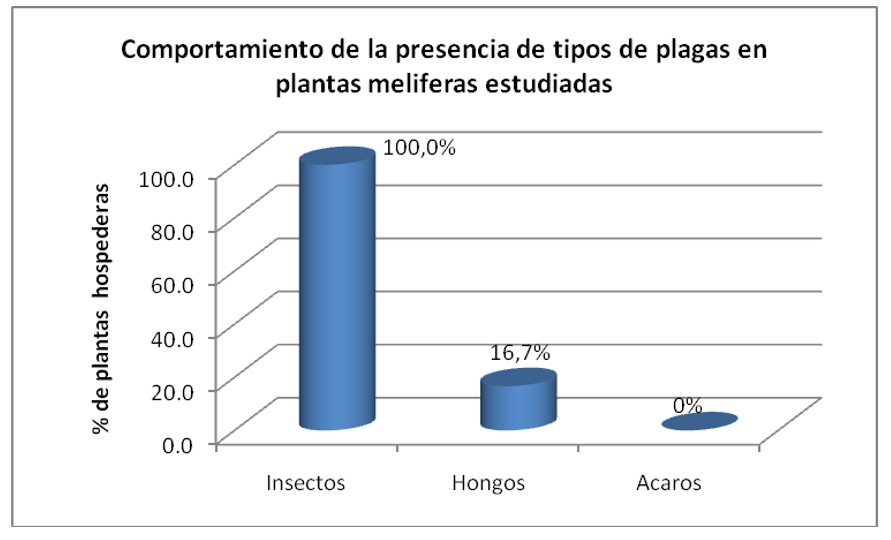-
Main Article Content
Abstract
A work of literature search on the subject of pests and diseases that attack plants of potential bee, and different control methods have been used to counteract its effect, is organized as a unified information in a manual with the aim of beekeeper provide the knowledge on the subject that will allow an efficient mode of operation and control the observance of these anomalies in the honey plants, greater use of organic and ecological practices, with the intention to preserve the environmental conditions that favor the achieve optimal activity of bees and honey production.
The method was preferably used from the literature review of research by authors from different national and foreign institutions, just as we searched information about the work being done several years ago by the National Center for Plant Health in coordination with other foreign institutions, on Integrated Pest Management (IPM).
Article Details

This work is licensed under a Creative Commons Attribution-NonCommercial 4.0 International License.
Those authors who have publications with this journal accept the following terms of the License Attribution-NonCommercial 4.0 International (CC BY-NC 4.0):
You are free to:
- Share — copy and redistribute the material in any medium or format
- Adapt — remix, transform, and build upon the material
The licensor cannot revoke these freedoms as long as you follow the license terms.
Under the following terms:
- Attribution — You must give appropriate credit, provide a link to the license, and indicate if changes were made. You may do so in any reasonable manner, but not in any way that suggests the licensor endorses you or your use.
- NonCommercial — You may not use the material for commercial purposes.
- No additional restrictions — You may not apply legal terms or technological measures that legally restrict others from doing anything the license permits.
The journal is not responsible for the opinions and concepts expressed in the works, they are the sole responsibility of the authors. The Editor, with the assistance of the Editorial Committee, reserves the right to suggest or request advisable or necessary modifications. They are accepted to publish original scientific papers, research results of interest that have not been published or sent to another journal for the same purpose.
The mention of trademarks of equipment, instruments or specific materials is for identification purposes, and there is no promotional commitment in relation to them, neither by the authors nor by the publisher.
How to Cite
References
Brechelt, Andrea (2004). El Manejo Ecológico de Plagas y Enfermedades. Red de Acción en Plaguicidas y sus Alternativas para América Latina (RAP-AL), pp. 4 - 11
Cabello, Alejandro (1966). Plagas y enfermedades. Editora Pedagógica, pp. 374 – 403 .
Centro Nacional de Sanidad Vegetal (2002). Programa de defensa forestal; Departamento de Programas de Defensa fitosanitaria del IIF, pp. 4-7, 9-21
Colectivo de autores (2007). Manejo Integrado de Plagas. Manual Practico. Biopreparados. pp. 19 - 526
Hernández, Doris; González, Caridad (1986).Cochinillas de los cítricos. Boletín de reseñas, cítricos y otros frutales. pp. 10 – 67
Instituto de Investigaciones de Cítricos y Fruticultura (1987). Cítricos y otros frutales. Ciencia y Técnica en la Agricultura, ISSN 0138-8835, V.10, No.2 pp. 8789
Instituto de Investigaciones Forestales (2002). Programa de defensa forestal. Departamento de defensa fitosanitaria pp. 4-7; 9-11; 16-21 .
Manso García, Diego Milán (1970). Breves apuntes sobre algunos insectos forestales y su control. INDAF, pp. 8-11
Martínez Rivero, Ma. de los Ángeles; Suris Campos, Moraima; Blanco, Eleazar (2004). Biodiversidad de la fauna de las cochinillas harinosas en Cuba. Revista de protección vegetal. Volumen 19 No. 3, pp. 170
Pérez Consuegra, Nilda (2004). Manejo Ecológico de Plagas, 10- 53 .
Vázquez Moreno, Luis L. (2003). Manejo Integrado de Plagas. Preguntas y respuestas para extensionistas y apicultores; CIDISAV, pp. 3- 40 .
Zamora Victoria y Casin J (1986). El genero Phytopthora como causante de enfermedades en los cítricos. Boletín de reseñas, pp. 3-15.
